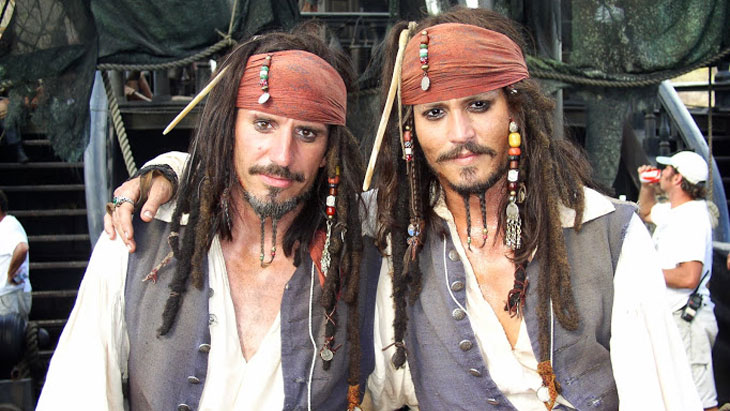
Tony Angelotti stunt doubling Johnny Depp in the first ‘Pirates of the Caribbean’ movie. Image credit: Courtesy of Tony Angelotti
By:
Emilie Lorditch, Inside Science
(Inside Science) -- While watching an action scene in a movie, most viewers are so engrossed in what is happening on the screen that they don’t notice that the actor has been temporarily replaced by his or her stunt double. Our brains are master multitaskers that keep us alive and help us recognize danger and yet both of these brain responses can help film editors "fool" the brain into thinking what we are seeing is seamless.
"We think we are seeing Johnny Depp portraying Jack Sparrow in the 'Pirates of the Caribbean' films, but it is actually his stunt double, Tony Angelotti," said Alina Liberman, a graduate student in neuroscience at the University of California in Berkeley, California. "Although this seems like a mistake that the brain should avoid making, it actually helps us see the world as more stable and continuous."
This brain vulnerability is actually a strength that film editors count on while sewing together the pieces that make up a film’s story.
"I'm shocked at how much we can get away with," said Norman Hollyn, a professor of cinematic arts at the University of Southern California in Los Angeles. "If the audience is totally into the story and really interested, they will forgive a lot."
Hollyn explains that film editors focus on cuts in scenes that won’t appear too jarring to the audience and cause them to stop believing in what they are seeing on the screen.
"We are attracted to things that move," said Hollyn. "We pay attention to things like large movements because usually, things that move are more important than things that don’t move."
Which makes sense instinctually because a large animal moving quickly towards you would elicit your "fight-or-flight" response. "We distract the audience with a large movement specifically away from the face," said Hollyn.
A thrilling car chase would fit the bill as a scene with large objects moving fast where a stunt double might be used. But what about scenes where the audience is looking at the actor’s face?
The face is the most recognizable feature of a person and researchers have found that the brain can even confuse that.
"We found that how we see faces can actually be wrong," said Liberman. "It can be biased by faces we’ve just recently seen."
During the study, participants were presented a face for 750 milliseconds and the researchers found that people’s perception of that face was biased by faces they saw in the previous 5-10 seconds.
"From moment to moment, our visual system sees something new and different because of things like frequent, small eye movements and changes in lighting,"said Liberman. "However, our brain somehow creates a very stable and continuous perception of the world so that we don't notice this visual disorder and without this mechanism, if we were talking to our friend and they turned their head or put on a hat, they might look like a totally different person."
So while watching a movie, our brain is constantly helping us put all the pieces together so that we can actually enjoy the movie and not be distracted by every light shift in a scene or change in actor.
"The visual system sacrifices accuracy and sensitivity in favor of stability," said Liberman. "As a result, we lose sensitivity to things like stunt doubles, but that is a small price to pay for visual stability."
Emilie Lorditch is an editor and writer for Inside Science TV; she tweets @EmilieLorditch. Reprinted with permission from Inside Science, an editorially independent news product of the American Institute of Physics, a nonprofit organization dedicated to advancing, promoting and serving the physical sciences.




Comments